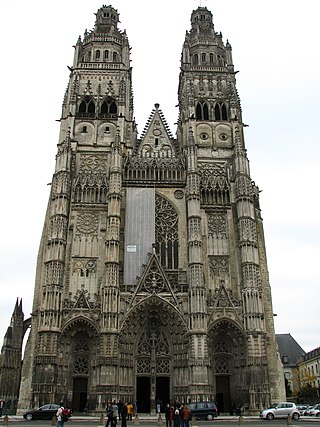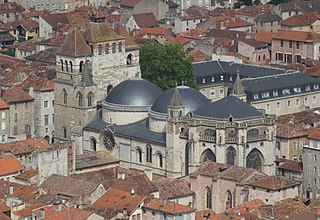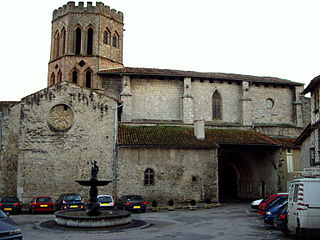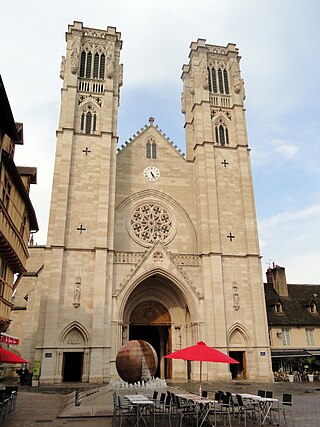
The Archdiocese of Tours is a Latin Church archdiocese of the Catholic Church in France. The archdiocese has roots that go back to the 3rd century, while the formal erection of the diocese dates from the 5th century.

The Bishop of Lausanne was the principal ecclesiastical authority of the Catholic Diocese of Lausanne.

The Archdiocese of Rouen is a Latin Church archdiocese of the Catholic Church in France. As one of the fifteen Archbishops of France, the Archbishop of Rouen's ecclesiastical province comprises the greater part of Normandy. The Archbishop of Rouen is currently Dominique Lebrun.

The Diocese of Meaux is a Latin diocese of the Catholic Church in France. The diocese comprises the entire department of Seine-et-Marne. It was suffragan of the Archdiocese of Sens until 1622, and subsequently of Archdiocese of Paris.

The Diocese of Gap and Embrun is a Latin Church ecclesiastical territory or diocese of the Catholic Church in Provence-Alpes-Côte d'Azur region of Southern France.

The Diocese of Digne is a Latin Church ecclesiastical territory or diocese of the Catholic Church in France. Erected in the 4th century as the Diocese of Digne, the diocese has been known as the Diocese of Digne–Riez–Sisteron since 1922. The diocese comprises the entire department of Alpes-de-Haute-Provence, in the Region of Provence-Alpes-Côte d'Azur. The diocese was a suffragan diocese of the Archdiocese of Aix-en-Provence and Arles until 2002 and is now a suffragan diocese in the ecclesiastical province of the metropolitan Archdiocese of Marseille. The Bishop of Digne's cathedra is found in Digne Cathedral at the episcopal see of Digne-les-Bains.

The Diocese of Tulle is a Latin Church diocese of the Catholic Church in Tulle, France. The diocese of Tulle comprises the whole département of Corrèze.

The Diocese of Nice is a Latin diocese of the Catholic Church in France. The diocese comprises the Department of Alpes-Maritimes. The diocese is a suffragan of the Archdiocese of Marseille.

The Diocese of Bayeux and Lisieux is a Latin Church diocese of the Catholic Church in France. It is coextensive with the Department of Calvados and is a suffragan to the Archdiocese of Rouen, also in Normandy.

The Diocese of Vaison was a Roman Catholic diocese in France, suppressed in 1801, with its territory transferred to the Diocese of Avignon. It had been one of nine dioceses in the ecclesiastical province presided over by the archbishop of Arles, but a later reorganization placed Vasio, i.e. today's Vaison-la-Romaine, under the archbishop of Avignon. Jurisdiction inside the diocese was shared between the bishop and the Comte de Provence, higher justice and the castle belonging to the Comte, and civil justice and all other rights belonging to the bishop. The cathedral was served by a chapter which had four dignities: the provost (praepositus), the archdeacon, the sacristan, and the precentor. There were also six canons, each of whom had a prebend attached to his office.

The Diocese of Cahors is a Latin Church diocese of the Catholic Church in France. The diocese comprises the whole of the department of Lot.

The Diocese of Valence (–Die–Saint-Paul-Trois-Châteaux) (Latin: Dioecesis Valentinensis ; French: Diocèse de Valence is a Latin Church diocese of the Catholic Church in southern France. The contemporary diocese is co-extensive with the department of Drôme.

The former French Catholic diocese of Riez existed at least from fifth century Gaul to the French Revolution. Its see was at Riez, in the modern department of Alpes-de-Haute-Provence.

The former French Catholic diocese of Couserans existed perhaps from the fifth century to the French Revolution in the late eighteenth century. It covered the former province of Couserans, in south-west France. Its episcopal seat was in Saint-Lizier, a small town to the west of Foix. It was a suffragan of the archdiocese of Auch.

The former French Roman Catholic Diocese of Saint-Paul-Trois-Châteaux, sometimes, just like the town, also known as the Diocese of Saint-Paul-en-Tricastin, existed from the sixth century to the French Revolution.

The Diocese of Nevers is a Latin Church diocese of the Catholic Church in France. The diocese comprises the department of Nièvre, in the Region of Bourgogne.

The Roman Catholic Archdiocese of Embrun was a Catholic jurisdiction located in southeastern France, in the mountains of the Maritime Alps, on a route that led from Gap by way of Briançon to Turin. It had as suffragans the Diocese of Digne, Diocese of Antibes and Grasse, Diocese of Vence, Diocese of Glandèves, Diocese of Senez and Diocese of Nice. Its see was the Cathedral of Nôtre Dame in Embrun.

The former French Catholic diocese of Apt, in southeast France, existed from the fourth century until the French Revolution. By the Concordat of 1801, it was suppressed, and its territory was divided between the diocese of Digne and the diocese of Avignon. Its seat was at Apt Cathedral, in Vaucluse.

The former French Catholic diocese of Chalon-sur-Saône existed until the French Revolution. After the Concordat of 1801, it was suppressed, and its territory went to the diocese of Autun. Its see was Chalon Cathedral.



















